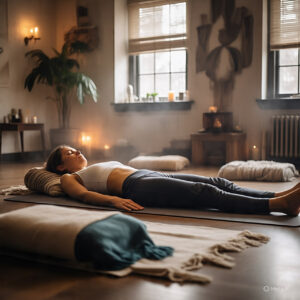
Restorative Yoga for Better Sleep: A Beginner’s Guide

In today’s fast-paced world, millions of people struggle with poor sleep quality. Stress, screen time, and busy schedules can all interfere with a good night’s rest. But what if there were a gentle, natural way to calm your mind and body before bed? Enter restorative yoga for better sleep — a soothing practice designed to help you relax deeply and drift into peaceful slumber.
In this beginner’s guide, we’ll explore what restorative yoga is, how it promotes better sleep, and how you can easily integrate it into your nighttime routine.
What is Restorative Yoga?
Restorative yoga is a slow, gentle form of yoga that focuses on deep relaxation and stress relief. Unlike dynamic styles such as vinyasa or power yoga, restorative yoga uses props like bolsters, blankets, and pillows to support your body in comfortable, restful poses.
Key characteristics of restorative yoga:
-
Poses are held for longer periods (typically 5–20 minutes).
-
The practice emphasizes stillness, breath awareness, and releasing tension.
-
It is accessible to people of all fitness levels, including beginners.
In short, restorative yoga creates the perfect environment for your nervous system to shift from “fight or flight” mode to “rest and digest” — an essential state for quality sleep.
How Restorative Yoga Enhances Sleep
You might be wondering: Why is restorative yoga good for sleep?
✅ Here’s how it works:
-
Calms the mind: The gentle, mindful movements help quiet racing thoughts and reduce anxiety.
-
Relaxes the body: Supported poses release muscle tension accumulated during the day.
-
Regulates the breath: Slow, conscious breathing soothes the nervous system and lowers heart rate.
-
Encourages a sleep-ready state: The practice triggers the relaxation response, helping you fall asleep more easily.
In fact, studies suggest that regular restorative yoga practice can help reduce insomnia symptoms and improve overall sleep quality.
A Beginner’s Restorative Yoga Sequence for Better Sleep
If you’re new to yoga, don’t worry — these beginner-friendly poses are simple, soothing, and require minimal effort. All you need is a quiet space and a few props (or alternatives like cushions and towels).
1️⃣ Supported Child’s Pose (5 minutes)
-
Kneel on the floor and place a pillow or bolster between your thighs.
-
Fold forward, resting your torso and head on the pillow.
-
Let your arms relax by your sides.
-
Breathe slowly, letting your body melt into the support.
Benefit: Gently stretches the back and hips while calming the mind.
2️⃣ Reclined Bound Angle Pose (5–7 minutes)
-
Lie on your back and bring the soles of your feet together, letting your knees fall out to the sides.
-
Place cushions under your knees for support.
-
Rest your hands on your belly or by your sides.
Benefit: Opens the hips and chest while promoting deep relaxation.
3️⃣ Legs Up the Wall (5–10 minutes)
-
Sit sideways next to a wall, then swing your legs up so they rest vertically against the wall.
-
Let your arms rest out to the sides, palms up.
-
Focus on slow, steady breathing.
Benefit: Reduces swelling in the legs, eases fatigue, and quiets the nervous system.
4️⃣ Savasana with Pillow Support (5–10 minutes)
-
Lie flat on your back. Place a pillow under your knees to release tension in the lower back.
-
Let your feet fall out naturally, arms relaxed at your sides.
-
Close your eyes and simply breathe.
Benefit: Encourages full-body relaxation and prepares you for sleep.
Tips for Creating a Restorative Yoga Sleep Ritual
Adding restorative yoga for sleep into your nightly routine doesn’t have to be complicated. Here are some easy ways to make it a habit:
Set a regular time: Aim to practice at the same time each evening, ideally 30–60 minutes before bed.
Create a calming space: Dim the lights, use a soft blanket, and eliminate distractions.
Pair yoga with other sleep-friendly habits: Try journaling, herbal tea, or listening to soft music along with your practice.
Focus on your breath: Throughout your yoga session, keep bringing your attention back to slow, deep breathing.
Be gentle with yourself: The goal isn’t to stretch deeply or perfect each pose — it’s to relax.
The Benefits of Restorative Yoga Beyond Better Sleep
While this practice is wonderful for improving sleep, it offers many other advantages that support overall well-being.
Reduces stress and anxiety: By activating the parasympathetic nervous system, restorative yoga helps lower stress levels.
Supports digestion: Gentle poses can aid in digestion and reduce bloating or discomfort before bed.
Eases chronic pain: The deep rest provided by restorative yoga may help alleviate mild aches and pains.
Enhances emotional balance: Regular practice can create a greater sense of inner peace and resilience.
Improves flexibility over time: Even though it’s a passive practice, restorative yoga helps open and lengthen muscles gradually.
Restorative Yoga vs. Other Yoga Styles for Sleep
You might be asking: Why choose restorative yoga over other types of yoga before bedtime?
Here’s the difference:
-
Restorative yoga is slow, quiet, and meditative — ideal for winding down.
-
Vinyasa or power yoga can energize you, which is better suited for daytime practice.
-
Yin yoga also involves longer holds but focuses more on deep tissue stretch, while restorative yoga focuses on comfort and support.
For sleep, restorative yoga is often the most effective choice because of its emphasis on deep rest and stillness.
Final Thoughts
✅ Restorative yoga for better sleep is a simple, accessible practice that anyone can try — no fancy equipment or prior experience required.
By dedicating just 15–30 minutes a night to gentle, supported poses and mindful breathing, you can help quiet your mind, relax your body, and set the stage for restful, rejuvenating sleep.
So tonight, roll out your mat (or even just your blanket), dim the lights, and allow yourself to unwind. Sweet dreams await.